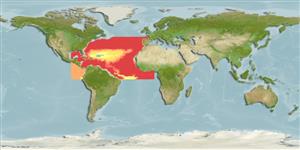Actinopterygii (peixes com raios nas barbatanas) >
Perciformes (Perch-likes) >
Chiasmodontidae (Snaketooth fishes)
Etymology: Chiasmodon: Name from the Greek 'chiasmos' which means diagonally arranged, and 'odous' for tooth or teeth..
Ambiente / Clima / Intervalo
Ecologia
; marinhas; intervalo de profundidade 700 - 2745 m (Ref. 58426), usually 750 - ? m (Ref. 6649). Deep-water, preferred ?; 46°N - 5°S, 95°W - 5°E (Ref. 82429)
North Atlantic: tropical and temperate; including Gulf of Mexico, from 95°W to 5°E, 46°N to 5°S (Ref. 82429). Southwestern Atlantic: Argentina (Ref. 44852).
Tamanho / Peso / Idade
Maturity: Lm ? range ? - ? cm
Max length : 25.0 cm SL macho/indeterminado; (Ref. 6944)
Vértebras: 43 - 44. This species is distinguished from its congeners by a set of characteristics: from C. braueri by the teeth on second ceratobranchial absent (vs. present) and supraorbital canal pores 7 (vs. 8); from C. harteli by total vertebrae 43-45 (vs. 47-48), supraorbital canal pores 7 (vs. six); from C. microcephalus by teeth on basibranchials well developed, 3-18, always present on second basibranchial and often on third basibranchial and second hypobranchial (vs. usually no teeth on basibranchials, rarely 1-3, small, restricted to second basibranchial); from C. pluriradiatus and C. asper, by pectoral-fin rays 13-14 (vs. 15-16), tiny dermal spinules on body of specimens larger than 45.0 mm absent (vs. with spinules), fang in premaxillary head 1 (vs. 2), and supraorbital pores 7 (vs. 8 and 9, respectively) and from C. pluriradiatus by lateral-line pores 86-93 (vs. 91-94); from C. subniger, by teeth on second basibranchial present (vs. none), infraorbital pores 14 (vs. 12-13, modally 13), snout elongate and pointed, 22.2-26.6% HL (vs. snout short and blunt, 21.4-23.9% HL), upper jaw 72.2-80.0% HL (vs. 63.9-72.7% HL), and lower jaw 80.0-86.7% HL (vs. 69.0-76.7% HL) (Ref. 82429).
Mesopelagic to bathypelagic species (Ref. 6944, 28429). Specimens larger than 4.5 cm are more frequently collected between 730 and 1900 m with shallowest record being 150 m, the deepest 3900 m (mean 1390 m). Juveniles are found in shallower water, from 0 to 1,050 m (mean 542 m), with the smallest specimens (>10.0 mm) collected nearest to the surface (Ref. 82429). Feed on whole fish, often of individuals longer than themselves (Ref. 9686). Most specimens were taken at depths greater than 750 m (Ref. 6649).
Life cycle and mating behavior
Maturidade | Reprodução | Desova | Ovos | Fecundidade | Larvas
Melo, M.R.S., 2009. Revision of the genus Chiasmodon (Acanthomorpha: Chiasmodontidae), with description of two new species. Copeia 2009(3):583-608. (Ref. 82429)
Categoria na Lista Vermelha da IUCN (Ref. 115185)
CITES (Ref. 94142)
Not Evaluated
Ameaça para o homem
Harmless
Utilização humana
Pescarias: sem interesse
Mais informação
ReferênciasAquaculturaPerfil para aquaculturaEstirpesGenéticaFrequência dos alelosHereditariedadeDoençasProcessamentoMass conversion
ColaboradoresFotografiasStamps, CoinsSonsCiguateraVelocidadeTipo de nataçãoÁrea branquialOutras referênciasCérebrosVisão
Ferramentas
Relatórios especiais
Descarregue XML
Fontes da internet
